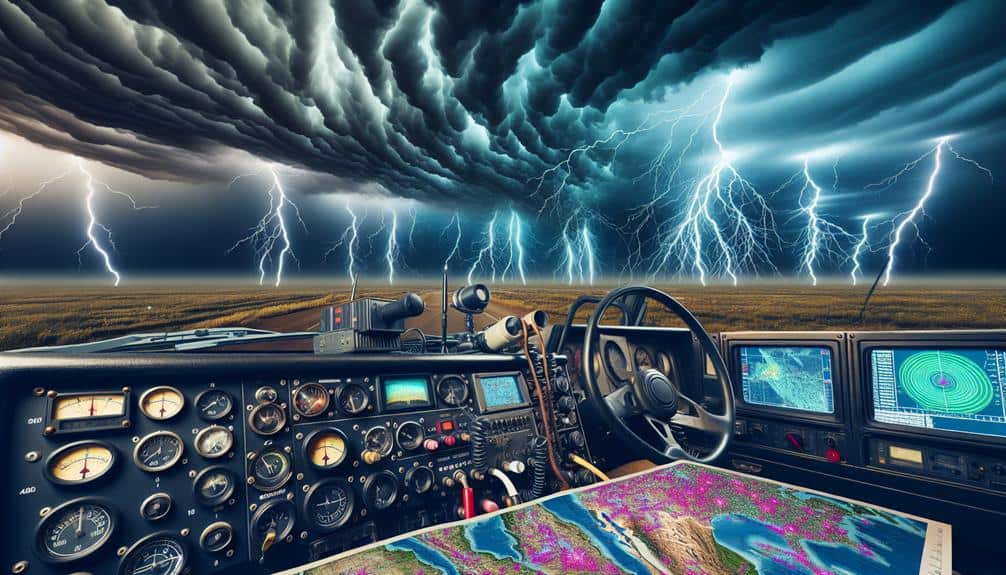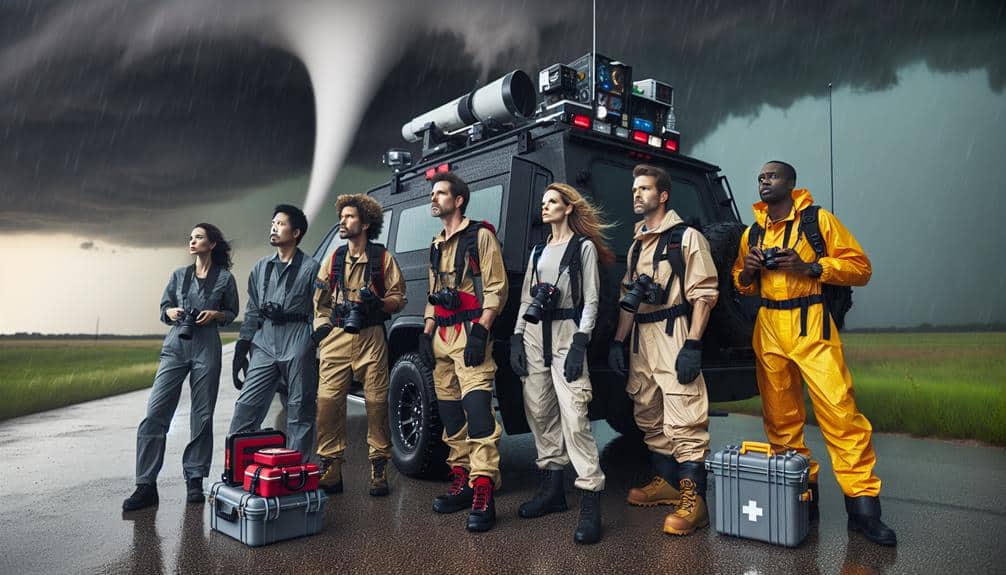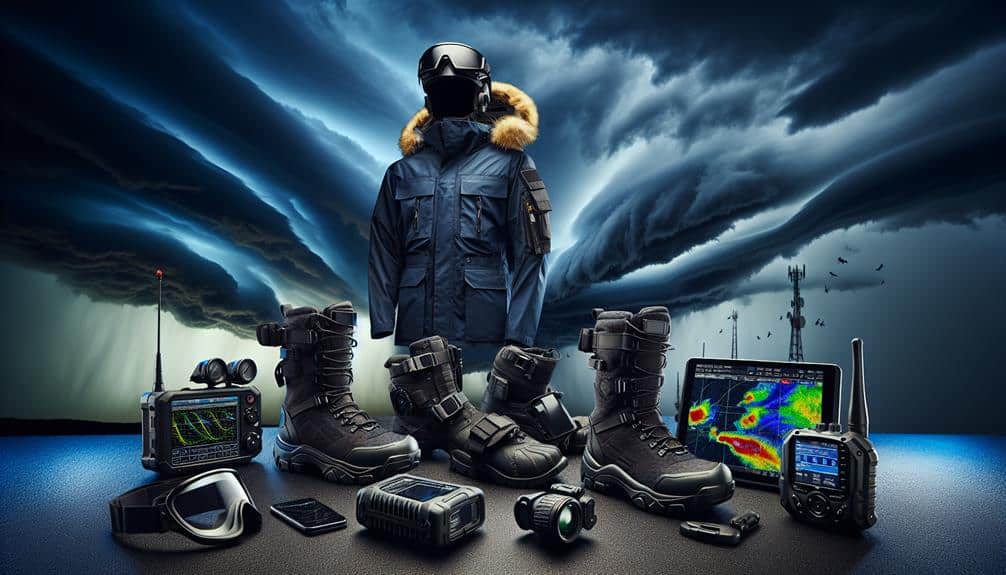Staying watchful as storm chasers demands us to closely monitor real-time weather updates using advanced tools like Doppler Radar and satellite imagery. We depend on durable, high-quality equipment, from weather instruments to protective gear. Planning multiple escape routes and using dependable communication channels secures safety and coordinated team efforts. By utilizing social media for real-time updates and employing emergency beacons, we can respond swiftly to emerging threats. Accessing live radar data and analyzing satellite imagery provides essential insights into storm movements. Utilizing weather models helps predict storm paths accurately. To explore these strategies further, stick around.
Key Points
- Regularly monitor real-time weather updates through apps and radar data for accurate storm tracking.
- Utilize durable protective gear and high-quality weather instruments for safety and effective storm analysis.
- Plan multiple escape routes using GPS and detailed maps to ensure safe navigation during storms.
- Maintain strong communication lines with team members using two-way radios and satellite tracking technology.
Monitor Weather Updates
We must continuously monitor real-time weather updates from reliable sources to ensure our storm chasing activities are both safe and effective. Accurate weather tracking is vital for predicting storm patterns and making informed decisions. By leveraging advanced meteorological tools and data, we can stay ahead of sudden atmospheric changes that could pose risks. Tools like Doppler Radar, satellite imagery, and weather apps offer precise, up-to-the-minute information, allowing us to adjust our routes proactively.
Effective weather tracking isn't just about observation—it's also about integrating this data into our emergency response plans. With real-time updates, we can swiftly pivot, avoiding hazardous zones and ensuring we're always in the best position to observe safely. Collaborating with meteorological agencies and utilizing platforms like NOAA's Storm Prediction Center enhances our situational awareness.
To maximize our freedom in the field, we rely on data-driven strategies. This means continuously cross-referencing multiple sources to validate our findings and anticipate potential threats. Real-time weather monitoring empowers us to act decisively, mitigating risks while maximizing our storm-chasing opportunities. Through methodical tracking and planning, we uphold both our safety and the excitement of the chase.
Use Reliable Equipment
To guarantee our data collection is accurate and our safety is uncompromised, we must prioritize the use of reliable equipment. Utilizing advanced weather instruments, durable protective gear, and high-resolution cameras will greatly enhance our ability to analyze storm patterns and document events.
Each piece of equipment plays a crucial role in our operations, providing us with the precision and resilience needed in the field.
Advanced Weather Instruments
Utilizing state-of-the-art weather instruments guarantees storm chasers gather accurate data essential for predicting severe weather patterns. By integrating advanced technology, we enhance our storm tracking capabilities and refine our data analysis processes, leading to more precise weather prediction models. Technology advancements have revolutionized our approach, allowing us to collect real-time data and make informed decisions on the field.
Our toolkit for storm chasing includes a range of sophisticated instruments:
- Doppler Radar Systems: These provide detailed insights into storm structure and motion, enabling us to track storm cells with high accuracy.
- Anemometers: Essential for measuring wind speed and direction, which are critical parameters in understanding storm intensity.
- Weather Balloons: Equipped with sensors, these balloons collect atmospheric data from various altitudes, offering a vertical profile of temperature, humidity, and pressure.
- Satellite Imagery: High-resolution images help us monitor large-scale weather systems and their evolution over time.
Durable Protective Gear
While advanced weather instruments provide crucial data, storm chasers must also equip themselves with durable protective gear to ensure safety amid severe conditions. Our choice of gear isn't just about comfort; it's about survival when we're out in the field.
Waterproof boots are essential, ensuring our feet remain dry and reducing the risk of hypothermia. They also provide necessary traction on slick terrain.
Durable jackets, ideally with windproof and waterproof capabilities, protect us from extreme weather elements, keeping our core temperature stable.
Impact-resistant helmets are non-negotiable. They shield us from debris that can be hurled by high winds, markedly reducing the risk of head injuries.
Alongside helmets, sturdy gloves are crucial. They not only keep our hands warm but also provide a solid grip on equipment and vehicle handles, especially in wet conditions.
Data from storm chasing incidents underscores the importance of this gear. Reports indicate that injuries often occur due to insufficient or inadequate protective gear. By investing in high-quality, durable equipment, we minimize these risks and maximize our operational efficiency.
Let's remember: our freedom to chase storms hinges on our preparedness and protection. Safety is paramount, and durable gear is our first line of defense.
High-Resolution Cameras
High-resolution cameras are essential tools, capturing vital details that can be analyzed to understand storm behavior accurately. When we're out in the field, the significance of reliable equipment can't be overstated. High-resolution cameras enhance our ability to document weather phenomena, providing clear images and video recordings that are essential for analysis.
Proper camera positioning is crucial to guarantee optimal image quality. We typically mount our cameras on sturdy tripods or vehicle mounts to keep them steady in high winds. This practice helps us avoid blurry images, ensuring each frame is clear and detailed.
Here's a quick rundown of what we focus on:
- Sensor Resolution: Higher sensor resolutions capture more detail, aiding post-storm analysis.
- Frame Rate: High frame rates are essential for video recording, allowing us to slow down footage without losing clarity.
- Lens Quality: Premium lenses enhance image sharpness and reduce distortions, which is vital for accurate weather documentation.
- Durability: Our cameras need to withstand harsh weather conditions, from torrential rain to flying debris.
Plan Escape Routes

Effective storm chaser strategies require careful planning of multiple escape routes to guarantee safety during rapidly changing weather conditions. We must prioritize risk assessment and emergency response as essential components of our preparation. By evaluating the potential hazards in various storm scenarios, we can develop strong navigation plans that provide us with a clear course of action under different circumstances.
Our navigation planning should include detailed maps of the areas where we intend to chase storms, paying close attention to road networks, potential choke points, and safe zones. We need to utilize GPS technology and real-time data feeds to keep our routes updated and adaptable. Being dynamic in our approach ensures we can pivot quickly if the situation demands it.
A solid communication strategy is crucial in this process. We should establish reliable communication channels among our team members and with local emergency services. This guarantees that everyone is aware of the current plan and any necessary changes. Coordination and timely updates are vital to avoid missteps that could put us in harm's way.
Stay Connected
Maintaining strong communication lines is crucial to guarantee that our team remains informed and coordinated during storm chases. Effective communication isn't just about having the right tools; it's about integrating them seamlessly into our workflow. We rely on a combination of emergency communication devices, real-time weather apps, and satellite tracking to stay ahead of the storm and make data-driven decisions.
Here's how we secure we're always connected:
- Two-Way Radios: These provide reliable communication even when cellular networks fail, essential for emergency communication.
- Weather Apps: We utilize top-tier weather apps for real-time updates and alerts, giving us a competitive edge in rapidly evolving scenarios.
- Satellite Tracking: This technology allows us to monitor storm patterns and our positions, ensuring we avoid the storm's most dangerous areas.
- Social Media: Platforms like Twitter offer real-time reports from other chasers and meteorologists, enriching our situational awareness.
Understand Storm Patterns

To enhance our storm chasing accuracy, we must monitor weather forecasts rigorously, ensuring we're aware of real-time developments.
Analyzing historical data allows us to recognize patterns and improve predictive models.
Monitor Weather Forecasts
Accurately interpreting meteorological data is vital for storm chasers to anticipate storm trajectories and potential hazards. By mastering the art of weather tracking, we enhance our emergency preparedness and improve our chances of safe and successful storm chases.
To achieve this, we rely on a combination of storm spotting and radar monitoring to stay ahead of developing weather patterns.
To effectively monitor weather forecasts, we should:
- Utilize Real-Time Radar Data: Accessing live radar data allows us to pinpoint storm locations and their intensities, essential for making swift decisions.
- Analyze Satellite Imagery: High-resolution satellite images provide a broader perspective on storm systems, helping us understand their structure and movement.
- Leverage Weather Models: Numerical weather prediction models offer forecasts based on current data, enabling us to project storm paths and potential impact zones.
- Monitor Weather Alerts: Keeping an eye on official weather alerts and advisories ensures we're aware of any sudden changes or new developments.
Study Historical Data
Analyzing historical storm data allows us to identify recurring patterns and better predict future storm behavior. By carefully studying past storm occurrences, we can analyze trends and track patterns that often emerge. This data-driven approach empowers us to anticipate storm paths, intensity, and potential hazards with greater precision. Historical data provides a rich repository of information, highlighting how certain conditions lead to specific storm outcomes.
Through a thorough examination of variables like temperature shifts, pressure changes, and wind patterns, we can develop predictive models that enhance our vigilance. For instance, by tracking patterns from previous seasons, we might notice that certain regions are more susceptible to severe weather during specific times of the year. This knowledge grants us the freedom to prepare in advance and allocate resources more effectively.
Moreover, leveraging historical data allows us to identify anomalies and outliers, which can be crucial in forecasting rare but impactful events. The precision gained from this analytical approach ensures that we aren't just reacting to storms but proactively planning for them.
Identify Key Indicators
Identifying key indicators within storm patterns allows us to predict severe weather with heightened accuracy and readiness. By understanding the intricacies of weather patterns and storm development, we can enhance our vigilance and make informed decisions.
Let's break down the critical indicators:
- Atmospheric Pressure Drops: A sudden decrease in atmospheric pressure often signals storm development. Monitoring barometric pressure trends ensures early detection.
- Cloud Formations: Specific cloud types, such as cumulonimbus, serve as visual cues, indicating severe weather potential. Observing cloud shapes and movements is essential.
- Wind Patterns: Changes in wind speed and direction, especially shifting winds at different altitudes, provide clues about storm formation and intensity.
- Temperature and Humidity Levels: High humidity coupled with rising temperatures can create volatile atmospheric conditions conducive to storms.
Maintain Vehicle Readiness
Ensuring our vehicle is in top condition is vital for storm chasers, as it directly impacts our ability to safely and effectively track severe weather. We must prioritize vehicle maintenance to avoid breakdowns during pivotal moments. Regularly check the engine, brakes, tires, and fluid levels. A well-maintained vehicle enhances reliability, enabling us to navigate rugged terrains and escape hazardous conditions.
Emergency supplies are essential. Stock our vehicle with items like first aid kits, blankets, non-perishable food, and water. These supplies could be lifesavers if we're stranded. Equally essential is carrying safety gear, such as high-visibility vests, helmets, and sturdy footwear, ensuring we're protected when exiting the vehicle in adverse conditions.
Communication devices are our lifeline. Equip the vehicle with reliable two-way radios, satellite phones, and GPS systems. These devices keep us connected to fellow chasers and emergency services, ensuring we receive timely updates and can coordinate effectively.
Follow Safety Protocols

Adhering to established safety protocols is crucial to minimize risks and enhance our effectiveness during storm chasing operations. Our dedication to safety precautions and emergency response readiness guarantees that we can navigate hazardous conditions without compromising our wellbeing or data collection efforts.
To achieve optimal storm awareness and risk assessment, we follow these key protocols:
- Regularly update weather data: Staying informed with the latest meteorological information enhances our storm awareness, allowing us to make timely decisions.
- Pre-chase briefings: We conduct thorough pre-chase briefings to discuss potential risks, emergency response plans, and specific safety measures tailored to the day's conditions.
- Emergency equipment checks: Ensuring our emergency equipment, such as first aid kits, radios, and GPS devices, is operational and accessible at all times.
- Maintain communication: Constant communication among team members and with local authorities keeps everyone informed of evolving risks and facilitates coordinated responses.
Frequently Asked Questions
How Can Storm Chasers Protect Themselves From Lightning Strikes?
To protect ourselves from lightning strikes, we should follow lightning safety precautions and thunderstorm preparedness tips. Staying inside vehicles, avoiding tall structures, and monitoring weather updates are key strategies for ensuring our safety during storms.
What First Aid Supplies Should Storm Chasers Carry?
When the storm's fury rages, we need emergency response gear and wilderness medicine supplies. Pack a first aid kit with bandages, antiseptics, splints, and a tourniquet. Precision and preparedness guarantee we can chase the storm freely and safely.
How Do Storm Chasers Handle Encounters With Wildlife?
When we handle wildlife encounters, we prioritize safety precautions by understanding animal behavior and conducting thorough risk assessments. Our data-driven approach guarantees we respect wildlife and avoid unnecessary risks while maintaining our freedom to chase storms effectively.
What Personal Protective Gear Is Recommended for Storm Chasers?
When storm chasing, we always prioritize safety equipment and essential items. We wear protective gear like helmets, goggles, and reinforced clothing to handle severe weather conditions. Our analytical precision guarantees we stay prepared for any situation.
How Can Storm Chasers Manage Stress During Intense Storm Situations?
We manage stress during intense storm situations through mental preparation and relaxation techniques. Effective communication within our support system guarantees we stay focused, grounded, and safe, maintaining our freedom to chase storms responsibly and efficiently.


